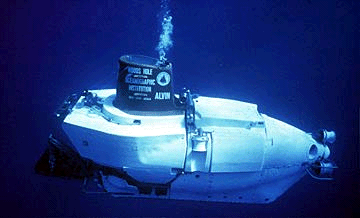Probing, Prying, Spying
Scientists test the water

Relatively little is known about oceans because they're so vast
and deep. In many ways, studying the oceans is much like
studying other planets. Scientists have had to devise ingenious
techniques to gather data over immense areas and to penetrate the
depths.
Although oceanographers will always need to go to sea in
ships to collect samples and make precise measurements, the only
way to survey large areas simultaneously is to take the long view
--from satellites in space.
Sampling
Moorings
"mind the lab" for long, uninterrupted periods, because
ships can't stay out of port indefinitely. These vertically
anchored cables suspend equipment in the water or place other
devices on the sea floor to record data on currents, water
temperature, or chemistry. Later, the ship returns, acoustically
signals the anchor to release, and retrieves the mooring and
equipment §.
Submersibles
Submersibles take scientists in for close-ups. Once, scientists
could only drag nets through the water or over the ocean floor--a
process that mainly captured slow-movers and often damaged the
animals collected. Now, advanced diving vessels and robotic
submersibles armed with special collecting devices and video
cameras catch deep-sea organisms in the act and leave them
intact.

Alvin, a three-passenger deep-submergence vehicle, can dive to
14,850 feet (4,500 m) §.
It has been instrumental in discovering many oceanographic features, including hydrothermal vents. Its titanium sphere houses sophisticated navigation,
scientific, and film and video equipment §.
photo © Woods Hole Oceanographic Institution
The
Johnson Sea Link is
prized for the views through
the plexiglass sphere.
photo © Tom Smoyer, Harbor
Branch Oceanographic
Institution
Reversing Nansen bottles
sample at specified depths.
Bottles (named after the
Norwegian oceanographer who
invented them) are attached to
a wire at measured points and
lowered into the water.
A cylindrical "messenger" sent
down the wire triggers the
bottle to reverse, break off a
thermometer inside (to record
temperature at that point),
take a sample, and send a
messenger to the next bottle.
CTD sensors
(for conductivity/
temperature/depth) give continuous on-the-spot readings. Subtle
changes along the water column in temperature or salinity may be
important. To locate them, scientists lower a CTD, attached to
sampling bottles so that data and water are collected at various
depths §.

Hauling aboard a CTD sensor with sampling bottles attached, after
a day's work. Onboard computers connected to the CTD have
collected the data.
photo © Lynne Talley, Scripps Institution of Oceanography, UCSD
Standard sea water
sets the standard for water sampling.
Oceanographic institutes need a way to standardize their
salinometers (to measure salt levels). To create a common
standard so that data can be compared around the world,
researchers use sea water prepared to an accurately known level
of conductivity and a salinity of 35 parts per thousand §.
Core drilling
hits pay dirt on the ocean floor. Sediments have
accumulated undisturbed on the deep ocean floor, providing the
most complete geologic record of the past 200 million years.
Studying sediments reveals biological, physical, and chemical
information about the oceans and the ocean floor and continents,
as well as details of the earth's past climate §.
Cores have provided evidence of changes in sea level due to ice
ages, as well as major geologic events such as the asteroid
strike that may have caused the extinction of dinosaurs §.
More Information
- Read an article from the October 1994 issue of Technology Review
on Down to the Sea in Robots
by J. Robert Fricke
- Office of NOAA Corps Operations - provides
vessel, aircraft, and personnel support to the survey, science, and research programs of NOAA
- Online Computer Model - Enter your local marine data and run the model to calculate the Dimethylsulphide (DMS) output of your local coastal waters.
 Ocean Planet Exhibition Floorplan
Ocean Planet Exhibition Floorplan

 gene carl feldman (gene@seawifs.gsfc.nasa.gov) &
gene carl feldman (gene@seawifs.gsfc.nasa.gov) &
Judith Gradwohl, Smithsonian Institution (Curator/Ocean Planet)



